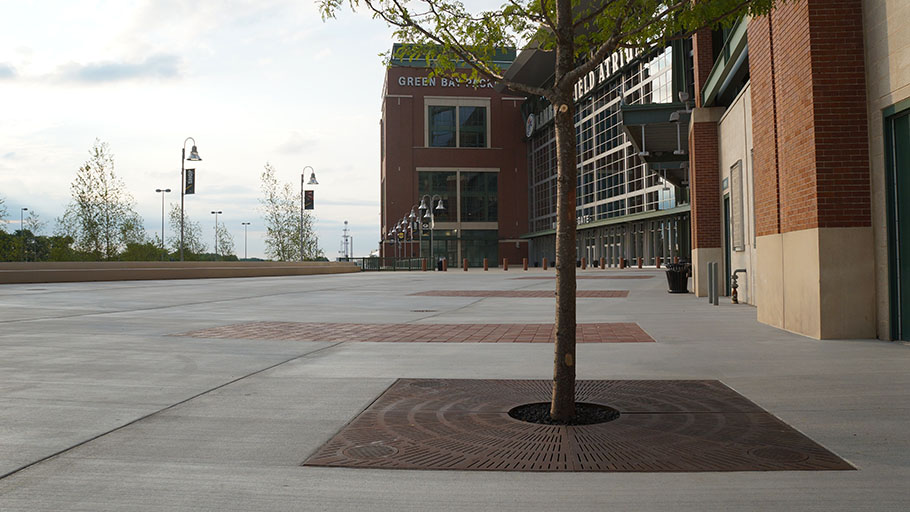Proper spacing for a range of bollard applications
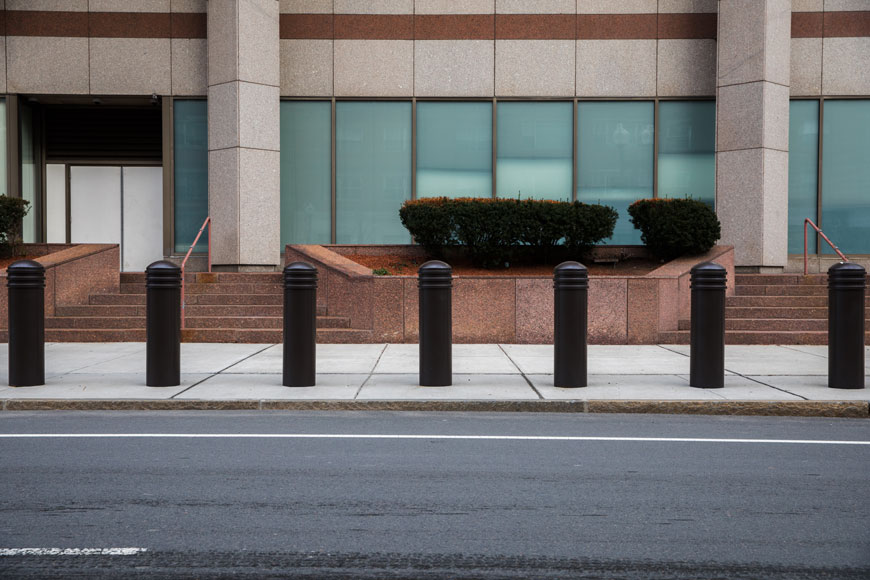
Whether to calm traffic, protect assets, or create visual perimeters around landmarks, bollards are functional, decorative posts used in everyday environments. Bollards come in a wide variety of aesthetics, from shiny stainless steel to traditional cast iron, or can be finished with vibrant powder coating to add a pop of color.
Bollards may be high or low impact resistant. Some are meant to stand strong against vehicles, while others are non-abrasive, bending upon impact and function only as visual barriers. Bollards serve to protect pedestrians and infrastructure, as well as control traffic flow. Each of these bollards have important, yet very different, purposes. Consider first the type of bollard, and then the site, to determine recommended installation practices and spacing for common bollard applications.
Bollard Installation Types
Bollard applications are versatile and can be fixed or removable, high or low impact. A few common installation methods exist for bollard applications in commercial and industrial settings. The first consideration is whether the bollard will be fixed and permanent, or used for changing access control. It is up to the installer to select the best installation method depending on the bollard’s requirements.
Fixed, crash-rated or high-impact mountings
Engineered crash-rated bollards or security bollards made of steel-and-concrete are installed to protect against vehicle impact. Crash-rated bollards have been tested to confirm their level of stopping power when installed as instructed. The impact resistance of security bollards is dependent on installation and the local substrate. Both types are embedded deep into the concrete substrate to become sturdy, fixed devices. Decorative bollard covers can be placed over top of these security posts for aesthetic enhancement. However, the bollard cover itself will not add to the level of impact resistance provided. For building security and pedestrian protection in areas vulnerable to vehicular traffic, this installation is one of the most reliable. These bollards are always sited near traffic and should be spaced accordingly.
Fixed, low-impact mountings
To permanently install bollards into new or existing concrete, mounting hardware such as threaded rods, anchor castings, or concrete anchors are used. Bollards may also be directly embedded into new concrete. When bollard applications are installed using these methods, they are primarily decorative, creating visual barriers around landscapes or monuments. They are without security features and have little impact resistance. They may be spaced to prevent human access.
Fixed, surface mountings
Surface mounting uses bolts and concrete anchors to secure bollards into existing concrete. No digging or pouring of concrete is necessary for this method. Although this installation does not offer much impact protection, they are helpful in protecting inventory from carts and other unpowered vehicles in warehouse spaces and grocery stores. This installation method also works well for bollards used to mark perimeters, such as separating lanes in a parking lot or to mark the end of a parking stall.
Removable mountings
By using removable mountings, bollards can be temporarily removed to allow access. Removable bollards are installed using special mounts into new or existing concrete. Lock pins and padlocks are used to secure the bollards to these mounts. However, this installation method offers little impact resistance. Removable bollards are an excellent way to changeably prevent and allow vehicle access into certain roads or event spaces. Their adaptability is also an excellent option for areas that need increased security during non-operating hours, such as at the entrance of a warehouse’s loading dock or public park.
Bollard spacing
When determining the spacing for bollards, it’s essential to consider their specific purpose. For traffic regulation and compliance with the Americans with Disabilities Act (ADA), it is recommended to space bollards no less than 3 feet apart. This ensures accessibility while maintaining safety. To effectively block the minimum width of a vehicle, spacing bollards no more than 5 feet apart is recommended. However, it’s important to note that bollards serve multiple functions, including storefront and building protection, campus security, sidewalk safety, utility protection, and safeguarding landmarks and plantings. These diverse applications may require different spacing configurations to suit their respective needs.
Very often, bollards are installed in a row, for increased visual awareness and to guard a larger perimeter. In these cases, how far apart should bollards be from one another, and from the curb? Read on to learn how site requirements directly impact bollard spacing.
Storefront or building protection
Impact-resistant bollards are often recommended when it comes to protecting valuable storefronts and the people inside them. Steel pipe security bollards are frequently used; however, due to their rough aesthetics, decorative bollard covers are used on top to add attractive design features. They can be matched to blend in with a building’s architectural design or corporate color scheme. When site planning, the speed and congestion of traffic, as well as building orientation must be examined.
Recommended bollard spacing
In areas where frequent pedestrian traffic can be expected, consider the Americans with Disabilities Act when site planning. There must be adequate spacing between bollard posts for all pedestrians, including those in wheelchairs and motorized chairs.
Maintain at least 3 feet between each post, and in the case of some fluted or solar bollard designs, be sure that the distance is measured from the furthest protrusion of the bollard. However, do not exceed 5 feet between each post, or the bollard’s ability to protect against a car will be compromised.

Campus and school ground security
Bollards are an effective way to mark the end of vehicular traffic and the start of pedestrian-only areas within school grounds and campuses. Place them in school bus areas, parent pick-up sites, around the entrance of the school, or at the top of a long flight of stairs. This also increases campus security as suspicious vehicles will not be allowed entry. By using removable bollards, temporary passage of service, delivery, or emergency vehicles will be allowed, while prohibiting unauthorized entry. To accommodate students and faculty who cycle to campus, consider using bike bollards.
Recommended bollard spacing
Areas with pedestrian traffic must follow standard bollard spacing of 3 to 5 feet between each post. Fire lanes and passages must allow for emergency vehicle access. Use the same spacing format for bike bollards as regular bollards. When measuring, be sure to measure between the furthest extension of the bike locking arms.
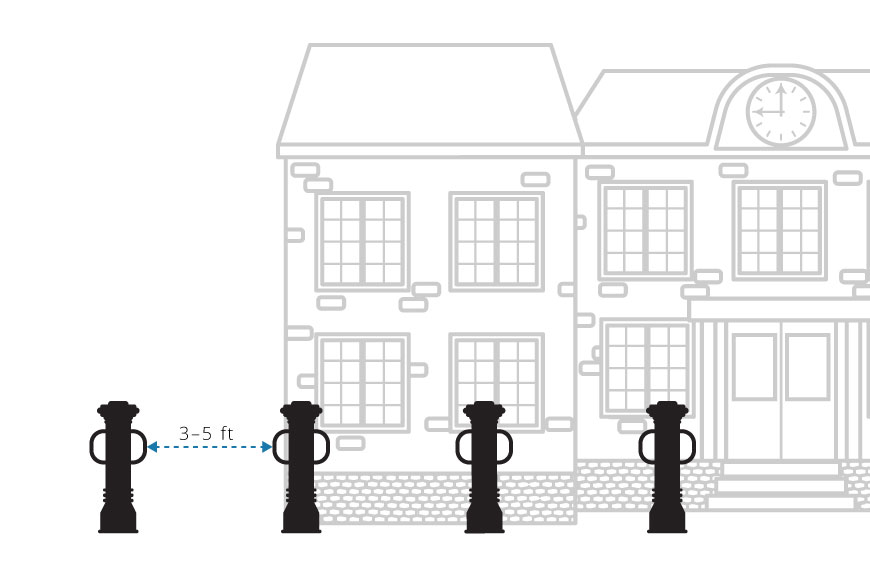
Sidewalk safety and traffic calming
Street bollards are a part of a traffic calming strategy that increases safer driving. At crosswalks and sidewalks, they provide visual cues to drivers that the curb is near and forms a physical barrier between pedestrians and vehicular traffic. They are also useful on median islands and curb extensions—an area where the sidewalk is extended, reducing pedestrian crossing distance and allowing them to see approaching vehicles better.
Recommended bollard spacing
Ideally, bollards should be placed 1.5 feet back from a curb where cars are allowed to park. This makes room for passenger side doors to open and space for passengers to disembark. If there is no vehicle parking allowed beside the bollards, they can be installed close to the curb. The distance between bollards should be between 3 and 5 feet, enough to allow for pedestrian traffic and wheelchair access, but close enough to deter the entrance of a vehicle. Always be aware of local codes and ordinances.
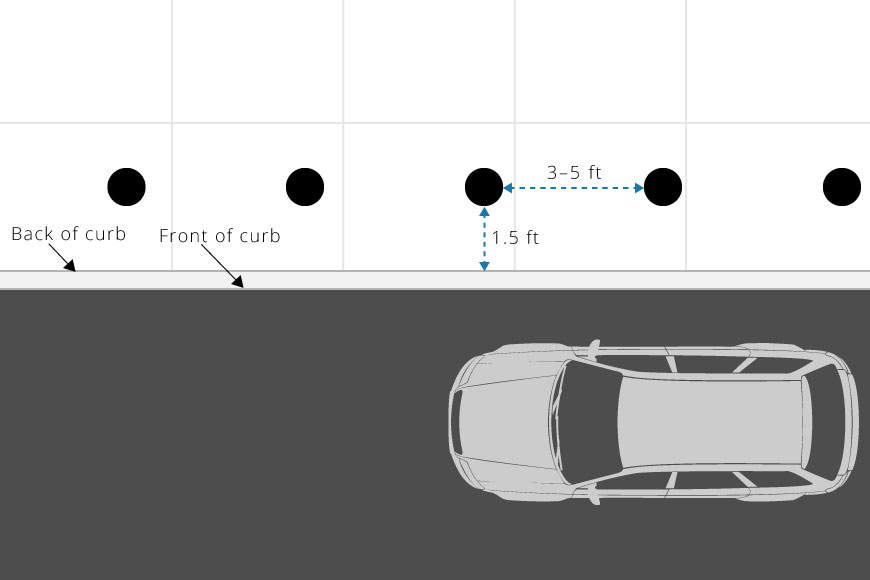
Asset protection
Use asset protection bollards when protecting electrical boxes or other utilities. This will keep vehicles a safe distance away, and will also discourage people from tampering or loitering. These handy bollards are also helpful in warehouse spaces or supermarkets to prevent carts and transfer vehicles from colliding into inventory. The main goal is to prevent foot traffic, slow-moving vehicles, and unpowered vehicles such as carts and strollers. Brushed stainless steel bollards can be used in commercial settings to match modern aesthetics, or opt for eye-catching powder-coated colors in areas such as warehouses where visibility is paramount.
Recommended bollard spacing
When protecting utilities that do not require pedestrian egress, bollard spacing can be close together if desired. If installing on private property, there may be even more flexibility around placement. Always be aware of local codes and emergency access when planning bollard installations. The mass and speed of the vehicles traversing the area will also have an impact on site planning. If traffic is aggressive, bollard spacing should be tightened and placed in close proximity to the utilities they are protecting. By spacing bollards close together, or connecting them with cross bars, they will create a stronger barrier.
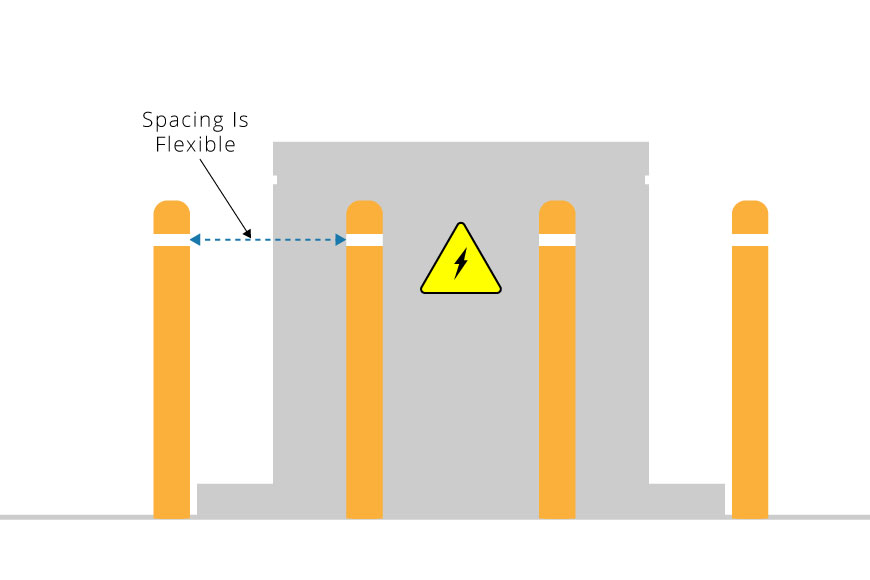
Architectural and landscape highlighting
Decorative bollards can be used as architectural accents and to define perimeters that are solely visual. They mark off areas to discourage entry, and they do so in a way that enhances the surrounding infrastructure. These bollards can also be connected with chains to further reinforce the barrier. The chains also provide aesthetic value, especially when set up around historical landmarks, sculptures, or manicured landscapes.
Recommended bollard spacing
Bollards that protect landmarks and sculptures can be spaced closer together since pedestrian traffic need not be considered—the goal is to stop pedestrians from intruding. Landmark and greenspace protection often occurs in public spaces, so bollard site planning must consider the needs of various emergency vehicles and ensure that they are not blocking any passages or fire lanes.
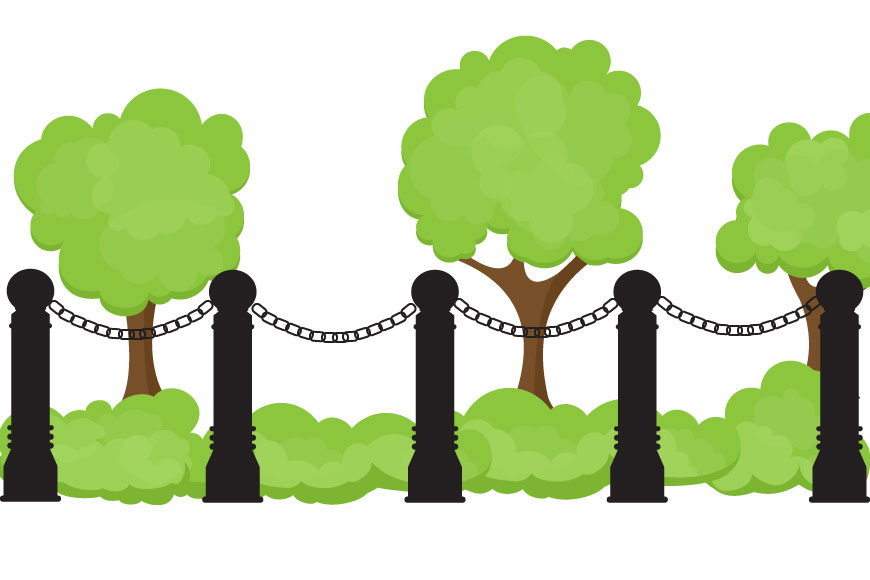
Loading dock security
Loading docks are where shipping containers meet the loading area of a warehouse for the loading and unloading of inventory. Trucks must back up into loading docks in such a way that the dock opening and truck bed opening will align. This can put a building’s exterior at risk of being accidentally hit as the truck may back up too far. Bollards can mark the width of the dock opening, increasing spatial awareness for drivers and making it easier for them to align the truck.
Removable bollards also provide access control of warehouse docks. When loading docks are not in use for a period of time, removable bollards can be set up to guard the dock opening. This prevents unauthorized trucks or vehicles from ram raiding—a method of stealing warehouse inventory by crashing through the warehouse opening. During operating hours, these versatile bollards can be easily removed.
Recommended bollard spacing
Bollards can be spaced at the discretion of the warehouse site planner. Typically, standard US bays have bumper plates with an outside dimension of approximately 8 feet, which matches the outside width of most shipping containers. A 6 inch gap is recommended on each side of the loading dock, resulting in the bollards being spaced 9 feet apart.
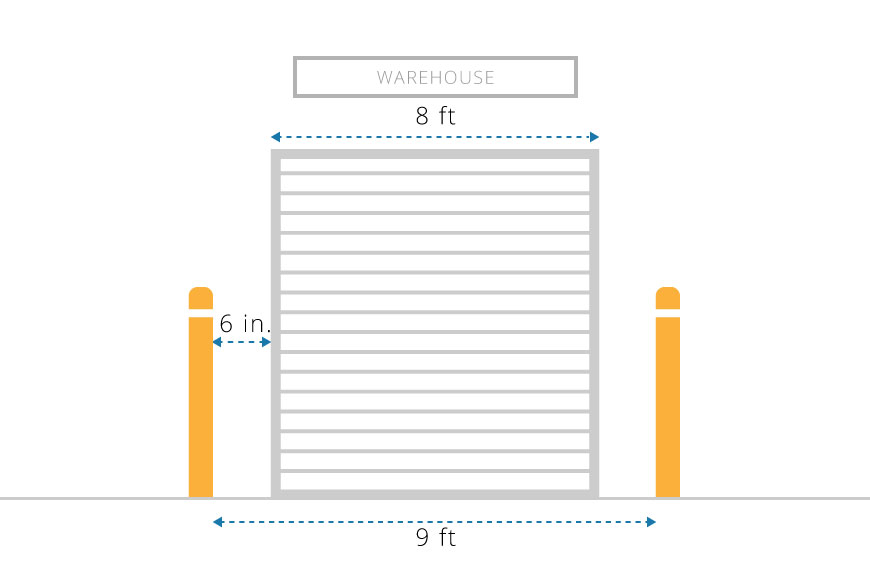
Cyclist protection and lane delineating
For cyclists, marked bike lanes on the road are often not enough to keep them safe. There is nothing preventing motorists from crossing over into the bike lane when making a right turn, or using them as parking lanes. Lane delineators force drivers to be aware that they are sharing the roadway with cyclists and to stay in their own lanes.
Flexible bollards have a tall profile and can be wrapped with reflective tape, so their visibility is clear to drivers, even during dark or rainy weather. The durable polyurethane material allows flexible bollards to bend upon impact and return to their original form right away. No harm is done to the vehicle, but awareness is heightened for both the motorist and cyclist.
Recommended bollard spacing
It is recommended to space flexible bollards 50 feet apart on straight sections of the road. In areas where the road curves, or at intersections, cyclists are more at risk. In these areas, bollards should be installed every 5 feet.

Parking lot safety
Flexible bollards can help guide traffic in congested areas such as parking lots that struggle to find an efficient traffic flow. Proper traffic control at parking lot entrances and exits alleviates the chaos that can lead to accidents. Flexible bollards offer clear demarcation and separates entry and exit lanes, limiting the chances of cars entering the wrong lanes. They may also be used to mark the end of a parking stall, preventing drivers from backing into a wall. Their height and color stand out in parking lot environments where many distractions exist. Parking bollards can also guard parking infrastructure such as ticket machines and officer booths.
Recommended bollard spacing
Bollards used for lane delineation in parking lots do not require pedestrian egress so bollard spacing can be close together if desired. The site planner can make the appropriate decision based on site requirements and safety. If using bollards to identify a crosswalk within a parking lot, the distance between bollards should be between 3 and 5 feet. This creates enough space for pedestrians and wheelchair access, but will not allow vehicles to pass.
For bollards used to mark the end of parking stalls, typically 2 bollards are installed for each parking space. They are to be centered within the width of the parking stall and spaced between 4.5 and 5 feet apart.
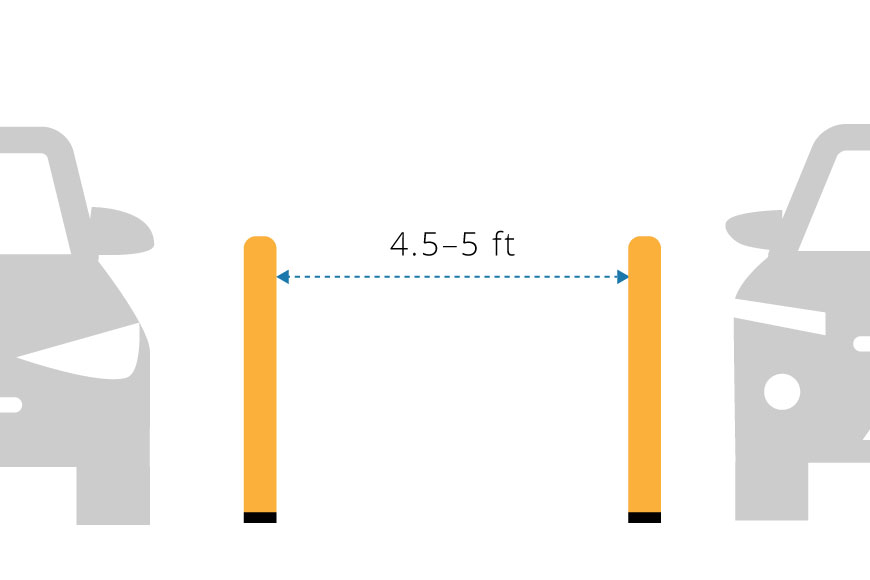
Special events and changing access needs
Some bollards are short-term, only required for certain events or to control access in multi-use spaces. Driveways, plazas, event spaces, and restricted laneways are examples of areas that can be cordoned off when required. Other outdoor spaces may be open to the public during regular hours, but need to be restricted during off-hours or off-season. Removable or retractable bollards can be taken down in under a few minutes, allowing for temporary perimeter security.
Recommended bollard spacing
In public multi-use spaces, smooth pedestrian traffic flow is a priority. Site planning must address this, as well as the Americans with Disabilities Act, and local building codes. As with other public spaces with pedestrian traffic, removable bollards must maintain a minimum of 3 to 5 feet between each post, measuring from the furthest protrusion of the bollard.
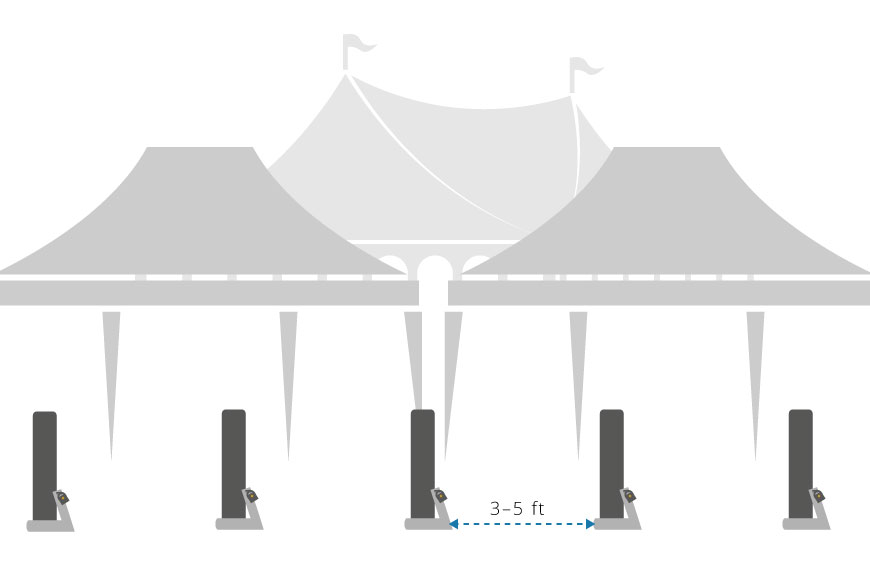
Bollard site planning takeaways
Bollards are a practical solution to creating safer urban spaces where pedestrians, cyclists, and motorists can exist in harmony. A variety of installation options give bollards a sense of utility and adaptability to changing spaces. Bollard spacing is just as important as the installation method, and has significant effects on bollard functionality, as well as pedestrian accessibility. Bollards that do not follow spacing standards may be infringing on local bylaws and ordinances and may be subject to removal. It is essential that site planners and installers appreciate local regulations and site requirements, as well as the desired outcome of the bollard application itself.











